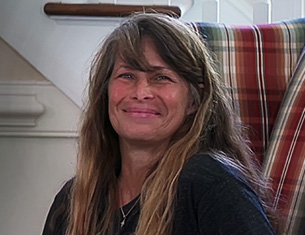A Constitutional Republic, where the First Amendment is Essential to OUR Survival
Breathing Easy
Publisher's Note: This article, written by Kathy Muse, was originally published in ECU News Services.
ECU research aims to minimize summer misery for outdoor workers
Summer months in eastern North Carolina mean hot, sticky days with heat indexes that can take the breath away, particularly for those who work outdoors. Add to that a respirator mask worn for job safety and misery levels soar into dangerous territory.
Research at East Carolina University aims to minimize discomfort for outdoor workers, while increasing their compliance with workplace safety requirements, through design of a lighter, thinner and more efficient respirator mask.
Dr. JoAnne Balanay, assistant professor in the Department of Health Education and Promotion, is conducting the research in collaboration with the University of Alabama, aided by a $20,000 research grant from the National Institute for Occupational Safety and Health.
“Wearing respirators against airborne pollutants is important for worker protection,” Balanay said. The correct respirator can keep workers from inhaling dangerous substances and reduce their risk of developing exposure-related diseases.
According to the United States Department of Labor, 5 million workers are required to wear respirators in more than 1 million workplaces throughout the country. But worker compliance with respirator requirements drops in the summer when temperatures rise.
“It is not easy to wear tight-fitting respirators for prolonged periods because it can be uncomfortable, especially in the hot and humid conditions of eastern North Carolina,” Balanay said.
“In addition to the burden on the lungs caused by breathing resistance through the respirator, extra discomfort is caused by heat buildup within the tight-fitting facepiece,” which increases facial sweating, she said.
Balanay is aiming to resolve the problem by evaluating designs of respirator cartridges and filters made of activated carbon fibers. Her research assesses the designs against airborne toluene vapors, a risk for workers in manufacturing, automotive body repair, construction and janitorial processes. Toluene is a volatile chemical found in paint, cleaning agents, adhesives and ink. It may be used to manufacture nylon, plastic soda bottles and dye.
 ECU professor Dr. JoAnne Balanay, left, and environmental health graduate student Adepeju Adesina are conducting research to develop a lighter respirator mask to improve workers' comfort levels and enhance their compliance with respirator regulations. (Photo by Jay Clark)
ECU professor Dr. JoAnne Balanay, left, and environmental health graduate student Adepeju Adesina are conducting research to develop a lighter respirator mask to improve workers' comfort levels and enhance their compliance with respirator regulations. (Photo by Jay Clark)
Balanay’s previous research identified activated carbon fibers as a good alternative to the standard granular activated carbon used in gas and vapor respirators currently on the market. The fabric form of carbon fibers is easier to handle and has a higher absorption capacity. Those features have the potential to significantly decrease the weight and thickness of respirators, while at the same time increase protection against exposure to dangerous chemicals.
ECU environmental health graduate student Adepeju Adesina assists in the lab. She tests combinations of cloth and felt materials made of the activated carbon to determine which respirator cartridge and filter designs allow workers to breathe most comfortably.
“Our research is aimed at designing efficient and comfortable respirators that meet NIOSH requirements,” she said. NIOSH is the National Institute for Occupational Safety and Health, which works to reduce workplace hazards.
Phil Lewis, assistant director of the ECU Office of Environmental Health and Safety, said the research could prove beneficial to workers. “Wearing a respirator while working for several hours can be uncomfortable, awkward and hot,” he said, but the thinner design “would encourage workers to use their respirator.”
Dr. Glen Gilbert agreed. Gilbert is dean of the College of Health and Human Performance, where the Department of Health Education and Promotion is housed. He said the research is “critical to the public health of eastern North Carolina.”
“If we can make it comfortable for workers to use respirators, it will pay great dividends in reduced health care costs down the road and greatly improve the quality of life for the users,” Gilbert said.
Go Back
ECU research aims to minimize summer misery for outdoor workers
Summer months in eastern North Carolina mean hot, sticky days with heat indexes that can take the breath away, particularly for those who work outdoors. Add to that a respirator mask worn for job safety and misery levels soar into dangerous territory.
Research at East Carolina University aims to minimize discomfort for outdoor workers, while increasing their compliance with workplace safety requirements, through design of a lighter, thinner and more efficient respirator mask.
Dr. JoAnne Balanay, assistant professor in the Department of Health Education and Promotion, is conducting the research in collaboration with the University of Alabama, aided by a $20,000 research grant from the National Institute for Occupational Safety and Health.
“Wearing respirators against airborne pollutants is important for worker protection,” Balanay said. The correct respirator can keep workers from inhaling dangerous substances and reduce their risk of developing exposure-related diseases.
According to the United States Department of Labor, 5 million workers are required to wear respirators in more than 1 million workplaces throughout the country. But worker compliance with respirator requirements drops in the summer when temperatures rise.
“It is not easy to wear tight-fitting respirators for prolonged periods because it can be uncomfortable, especially in the hot and humid conditions of eastern North Carolina,” Balanay said.
“In addition to the burden on the lungs caused by breathing resistance through the respirator, extra discomfort is caused by heat buildup within the tight-fitting facepiece,” which increases facial sweating, she said.
Balanay is aiming to resolve the problem by evaluating designs of respirator cartridges and filters made of activated carbon fibers. Her research assesses the designs against airborne toluene vapors, a risk for workers in manufacturing, automotive body repair, construction and janitorial processes. Toluene is a volatile chemical found in paint, cleaning agents, adhesives and ink. It may be used to manufacture nylon, plastic soda bottles and dye.
 ECU professor Dr. JoAnne Balanay, left, and environmental health graduate student Adepeju Adesina are conducting research to develop a lighter respirator mask to improve workers' comfort levels and enhance their compliance with respirator regulations. (Photo by Jay Clark)
ECU professor Dr. JoAnne Balanay, left, and environmental health graduate student Adepeju Adesina are conducting research to develop a lighter respirator mask to improve workers' comfort levels and enhance their compliance with respirator regulations. (Photo by Jay Clark)Balanay’s previous research identified activated carbon fibers as a good alternative to the standard granular activated carbon used in gas and vapor respirators currently on the market. The fabric form of carbon fibers is easier to handle and has a higher absorption capacity. Those features have the potential to significantly decrease the weight and thickness of respirators, while at the same time increase protection against exposure to dangerous chemicals.
ECU environmental health graduate student Adepeju Adesina assists in the lab. She tests combinations of cloth and felt materials made of the activated carbon to determine which respirator cartridge and filter designs allow workers to breathe most comfortably.
“Our research is aimed at designing efficient and comfortable respirators that meet NIOSH requirements,” she said. NIOSH is the National Institute for Occupational Safety and Health, which works to reduce workplace hazards.
Phil Lewis, assistant director of the ECU Office of Environmental Health and Safety, said the research could prove beneficial to workers. “Wearing a respirator while working for several hours can be uncomfortable, awkward and hot,” he said, but the thinner design “would encourage workers to use their respirator.”
Dr. Glen Gilbert agreed. Gilbert is dean of the College of Health and Human Performance, where the Department of Health Education and Promotion is housed. He said the research is “critical to the public health of eastern North Carolina.”
“If we can make it comfortable for workers to use respirators, it will pay great dividends in reduced health care costs down the road and greatly improve the quality of life for the users,” Gilbert said.
Latest Neighboring Counties
|
Republicans Bokhari and Driggs retain seats on city council.
Published: Tuesday, March 26th, 2024 @ 12:50 am
By: Carolina Journal
|
|
Members of the North Carolina Rural Health Association (NCRHA) visited Washington, D.C., on Feb. 14, 2024, to meet with elected officials and advocate for policies to improve access to care in rural areas.
Published: Wednesday, February 28th, 2024 @ 12:51 am
By: Eastern NC NOW Staff
|
|
The US Supreme Court will not take the case of Virginia-based owners of a Dare County beach home who challenged the county's COVID-related shutdown in 2020.
Published: Tuesday, February 6th, 2024 @ 10:14 pm
By: Carolina Journal
|
|
The North Carolina State Fair is set for the Raleigh state fairgrounds from October 12-22, 2023
Published: Friday, February 2nd, 2024 @ 9:01 am
By: Carolina Journal
|
|
A $2.5-billion-dollar bond referendum is slated to be placed on the November ballot this year, as Charlotte-Mecklenburg Schools (CMS) looks for support to fund 30 different projects in the school district.
Published: Sunday, January 14th, 2024 @ 10:08 am
By: Carolina Journal
|
|
Five Asheville-area residents are suing the city in federal court for refusing to appoint them to the local Human Relations Commission. The residents claim they were rejected because they are white.
Published: Saturday, December 9th, 2023 @ 11:53 am
By: Carolina Journal
|
|
Federal grant expands midwifery care for North Carolina
Published: Wednesday, November 29th, 2023 @ 2:59 pm
By: ECU News Services
|
|
Pirates achieve historic sponsored activities funding
Published: Tuesday, November 28th, 2023 @ 10:03 am
By: ECU News Services
|
|
Innovative new MBA pathway provides leadership experiences for students, companies
Published: Saturday, November 18th, 2023 @ 10:42 am
By: ECU News Services
|
|
Program immerses educators in conflict history, culture
Published: Friday, November 17th, 2023 @ 1:03 pm
By: ECU News Services
|
|
5,400 students descend on campus for the new academic year
Published: Wednesday, November 15th, 2023 @ 12:05 am
By: ECU News Services
|
|
ECU undergrads find guidance in SECU Public Fellows Internship program
Published: Tuesday, November 14th, 2023 @ 12:59 am
By: ECU News Services
|
|
Psychology major inspired by role in data internship
Published: Monday, November 13th, 2023 @ 7:57 am
By: ECU News Services
|
























